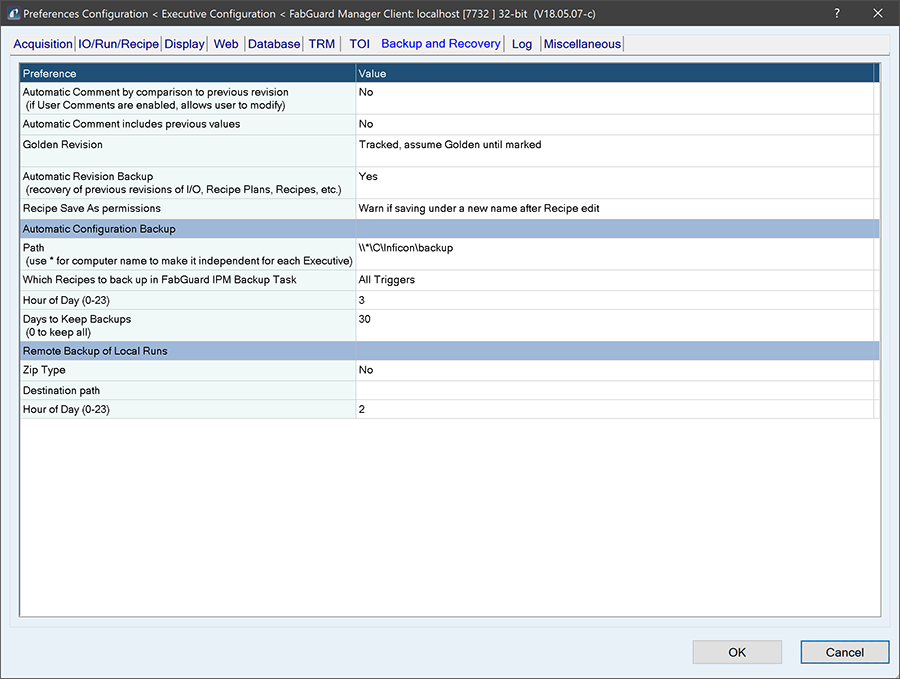November 2018
Final Phase Systems (FPS) Joins the INFICON Family »
Save the Date! FabGuard User Group Meeting June 4-6, 2019 »
Come See Us at an Event Near You »
FabGuard APC v5.03.00 Release »
Simplifying FabGuard Configuration Backup »
APC Conference 2018: Legacy Control System Replacement »
APC Conference 2018: Integrating 3rd Party Sensors to Reduce Scrap Events Using FabGuard »
Restoring FabGuard Computers for 24/7 Sustaining »
Support for Microsoft OLE DB driver for SQL Server (MSOLEDBSQL) »
The Ticket System is Now HTTPS. Change Your Bookmarks! »
End-of-Life Support for FabGuard Versions and Microsoft Products »
Simplifying FabGuard Configuration Backup
We are continuing to simplify the amount of setup required to ensure that the FabGuard system remains operational during and recoverable after factory outages and hardware failures. The most recent change is to replace all Backup Tasks with configurable preferences. The idea being that configuration back up should not be optional, but still needs to be configurable. Starting in version 18.05.06, all of the backup tasks have been removed, i.e., the following tasks no longer exist:
- Backup Task - Back up Executive and IPM Configurations
- Backup Task - Back up Reports and Models
- Backup Task - Create Configuration Summaries

Figure 1: The Backup and Recovery tab of Global Preferences showing the new Automatic Configuration Backup section.
Instead of requiring users to create the types of tasks listed above, FabGuard Executive will automatically perform a backup for itself, each FabGuard IPM, and Reports and Models in the database. This backup will also generate a Configuration Summary for each FabGuard IPM. The backup configuration is located in the “Automatic Configuration Backup” section of the “Backup and Recovery” tab in Global Preferences, Figure 1. As part of this backup process, backup directories older than a user configurable number of days are deleted. The FabGuard Executive log file contains backup status and any errors that occur during backup.
The “Automatic Configuration Backup” preference settings work as follows:
- “Path” is the destination to which everything is backed up. If the Board of Executives feature is used and Global Preferences are shared among board members, there is an option for “Path” to contain an asterisk in place of the computer name or IP address, for example \\*\ShareName\Folders. The asterisk is replaced by each FabGuard Executive’s computer name or IP address, depending on whether network identification is by computer name or IP address. The asterisk designation is used to make each FabGuard Executive have a different backup location
- "Which Recipes to back up in FabGuard IPM Backup Task" determines whether all Recipes in the Recipe Plan are backed up or only the Recipes for the Integration Type in use by each individual FabGuard IPM
- “Hour of Day” is the local time (hour only) at which the backup is performed
- “Days to Keep Backups” is the number of days for which backups should be kept. If the value is greater than 0, backups more than this many days old will be deleted
Upgrading From a Previous FabGuard Version
When upgrading from an older version that had backup tasks, Executive uses the first instance of an old “Backup Task - Back up Executive and IPM Configurations" task in the FabGuardExecutive.ist task configuration file to set the Global Preference for the new Path parameter in the “Automatic Configuration Backup”.
- Note that this means that if multiple old backup tasks backed up files to different locations, now everything will be backed up to the same location.
Remote Backup of Local Runs Configuration
The “Remote Backup of Local Runs” section of the “Backup and Recovery” tab in Global Preferences is not very new, but is relevant to this topic. This provides a way for FabGuard IPMs that are configured to save their Runs locally to optionally zip (compress) and move these Runs to network storage. It is generally recommended that FabGuard IPMs save Runs to their final network destination, rather than saving Runs locally and later copying or moving the local Runs to the network location. In situations where it is not possible for FabGuard IPMs to save Runs to their final network destination, using the parameters in “Remote Backup of Local Runs” is preferred over using the “Archive Task - Move Runs” task. Each FabGuard IPM performs its own remote backup if using “Remote Backup of Local Runs,” but if the Archive Task is used, all of the work is done by FabGuard Executive. FabGuard Executive will have to cycle through each remote backup, one FabGuard IPM at a time, which is slow and inefficient.
Future Simplification for Archive Tasks
More generally, we plan to further simplify tasks by removing all of the archive tasks:
- Archive Task - Copy Runs
- Archive Task - Move Runs
- Archive Task - Cleanup Runs
The “Archive Task - Copy Runs” task is not recommended, since it makes multiple copies of Runs. It is better to use network storage locations that are RAIDed and/or backed up externally.
The “Archive Task - Move Runs” task is no longer needed, because the “Remote Backup of Local Runs” option described above is better.
The “Archive Task - Cleanup Runs” task is no longer needed, because it is better to have each FabGuard IPM automatically delete old Runs rather than having Executive do this. The option for each FabGuard IPM to automatically delete old Runs is configured in the “IO/Run/Recipe” tab of Global Preferences using the “Days to Keep Runs” setting, Figure 2.
Summary
FabGuard configuration backup is now performed automatically by FabGuard Executive and does not require users to create tasks. This feature simplifies the amount of setup required for system maintenance and recovery.
